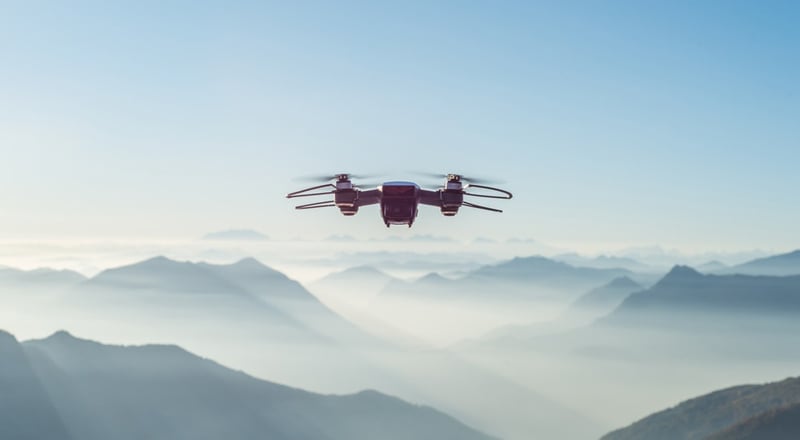The Age of Intelligent Automation
We live in a digital age. This means we are constantly seeing advancements in technology (which for some is exciting and progressive... to others it just means more confusing abbreviations and unexplained updates).
Here, we want to look into Intelligent Automation and learn from the big players such as Netflix, Spotify and Amazon.
What is Intelligent Automation?
First let’s try and explain what it actually is. Intelligent Automation is basically the merging of artificial intelligence (AI) and automation.
Intelligent Automation is the modern day magic that holds up marketing departments all around the world. It takes huge amounts of data, identifies and synthesises it, and uses it to learn, adapt, make decisions, guide processes and ultimately achieve exceptionable levels of efficiency and productivity. While this seems complex behind the scenes, marketing tools have worked hard to make it easy to use (and easy on the eye) for marketers everywhere!

Let’s take this back a few steps and firstly take a look at what marketing automation is. Marketing automation does exactly what it says on the tin. It automates marketing actions. Marketing automation typically refers to the software that marketers use to automate those repetitive tasks so that you, the creative marketer, have more time to do the things that require free-thinking or a little human touch.
But how can Artificial Intelligence (AI) help with automation? AI refers to machines that simulate human intelligence, i.e. they can learn, make decisions based on data and evolve without too much human contribution.
Related content: A Marketer's Guide to Artificial Intelligence
AI enhances marketing automation. Essentially, not only will your repetitive tasks be automated, they will be smartly automated. For example, if you use a tool to schedule emails, the tool would do more than just schedule the sending of the emails for a specific time that you set as the marketer. Instead, it would learn from when your users are most likely to open the email and send it to them around that time. This would give your campaign the highest possible chances of seeing an increase in open and click-through rates. This makes you a better marketer without even trying!
What are the benefits?
Intelligent automation has significant benefits for brands and marketers. Marketers can intelligently automate everything from emails, social posts and other website actions. This is great because it means you can regularly and efficiently engage with customers, gain customer intelligence, automate your sales process, improve ROI and streamline your workflow. Basically, intelligent marketing automation is going to become your best friend as it saves you precious time (which you can spend on the more fun, creative side of marketing) and improves your results (for when you are looking to ask for that cheeky raise!).
You might be wondering how you can add automation into your strategy. I can tell you now that it all depends on what your goals are.
There are a number of platforms that are worth looking into: If you want to intelligently automate email workflows and schedule social media posts, then it sounds like Hubspot is for you; if your aim is to intelligently automate segmentation based on behaviour and seamlessly integrate your marketing tools then Hurree may be your answer!
So when it comes to Intelligent Automation - which big brands are currently doing it best?
Our Top 3 Intelligent Automation Cases
-
Netflix
Netflix is one of the biggest and most successful film and TV series streaming services currently available. What was once a humble distributor of DVDs has now become a data-driven giant with over 137 million subscribers currently - a huge increase from 117 million in January 2018. According to Forbes, we can expect to see a healthy, consistent increase in subscriber growth from Netflix, which means more revenue and, fingers crossed, more and more captivating content.
For a brand that has been around for so long (*cough* since 1997), why is Netflix only just experiencing major popularity?
The answer, in short, is Intelligent Automation. Netflix uses Intelligent Automation to give continued value to subscribers by providing bespoke recommendations of films and TV shows. The great user experience (UX) they offer strengthens the brand's social media presence and brand personality.
How can Netflix achieve all that they do?
Data. Netflix has grown so much thanks to their huge pool of data, which is used to create exceptional user experiences, create fresh content and inform multimillion-dollar decisions. Their commitment to UX is what has made them renowned for achieving greatness when it comes to personalisation.
How do they do it so well?
The binge-watching beast takes note of users’ viewing habits and combines them with specific algorithms so that they can predict viewer behaviours. This is how they derive the recommended content and are able to create entirely personalised experiences.
Not only is personalisation an effective way to increase customer retention and improve UX, but Netflix also estimate that their algorithms save them around $1 billion a year in value, all from customer retention!
Now you may think that they just use Intelligent Automation to suggest new shows that they think you’ll absolutely love, but it doesn’t stop there. Netflix’s algorithm-driven focus on personalisation has led them to go a mile further by personalising the image that they show you when suggesting new shows.
Yes, you heard right.
Netflix’s image offerings are based on consumer viewing habits (i.e. the genre type or previous viewing behaviour including the stars). This means that if you continuously enjoy shows or films that involve a particular actor or actress, for example, Netflix will ensure that your preferred protagonist appears as the homepage image. This encourages you to click and helps Netflix's algorithm to learn.
Here is an example of how Netflix uses consumer data to intelligently automate the perfect image:
Netflix will always try to get to know you that little bit better. And because of their passion for personalisation and innovation, Netflix’s Intelligent Automation is perfect for creating consistent and advanced leaps that will not only influence consumer behaviour but the way that we watch TV shows and films forever.
2. Spotify
Spotify is one of the largest music streaming platforms in the world and it has had huge impacts on the music industry. It’s really no surprise that they also fully employ and embrace Intelligent Automation.
Spotify perfectly utilise the data that they have, and that’s why they are easily one of the most successful data-driven companies out there. Spotify’s constant stream of consumer data helps to improve their algorithms, which produces fresh insights and intelligent enhancements.
One of the most obvious ways that the big brand uses Intelligent Automation is to create their bespoke ‘Discover Weekly’ playlists that are created with you in mind. On a side note, you can now play with this algorithm and mix your own genres and other parameters on your browser!
And whilst some brands’ use of Intelligent Automation can be a bit ropey, Spotify’s personalisation of your audible experiences is generally on point. In addition to their Discover Weekly playlist, the brand also offer a ‘Daily Mix’ where you can expect to see your favourite songs and artists, along with some additional recommendations to keep you listening.
So does Spotify only use Intelligent Automation to make my playlists?
Absolutely not! Spotify also use it for behavioural segmentation, along with segmentation by other demographics and information, to optimise content, their audio ads and ‘Spotify Insights’.
It’s Spotify’s focus on their customer satisfaction and drive for innovation that really sets them apart from their competitors and helps them to achieve constant growth, a vibrant brand personality and an impressive following.
3. Amazon
In truth, it can be a bit tough to actually define what Amazon is. Do they sell clothes, food, movies, tech? Is Amazon a website, app, in-house robot, drone? Well, basically, Amazon encompasses all of those things I’ve just mentioned and more. Originally a website that sells books, Amazon can now shout from the rooftops that it’s the world’s largest online retailer. What an achievement! I’m sure Amazon would like to thank its friends, family etc., etc., but, let’s face it, the real success of this retail giant is down to Intelligent Automation.
Amazon uses marketing automation tools to maintain those all-important customer communications (via email, surveys and social media), as well as in its warehouse to streamline efficiency. In this way, Amazon’s automation techniques ensure great user experiences, customer service and constant satisfaction.
So what about the intelligence side of things?
Well, combined with automation, artificial intelligence powers three main Amazon products: Amazon’s Alexa, Amazon Go and the Amazon recommendation engine.
Alexa was one of the first of its kind, and now we see voice-powered virtual assistants popping up all over the market. Consumers use Amazon’s Alexa for so many different reasons, from listening to music and asking for the daily weather forecast, to making calls, online searching and playing games. Alexa is intelligent because she, like all AI robots, can learn and adapt.
Amazon Go is a store without cashiers - yep, no cashiers. So how do you pay for your products? With Intelligent Automation. Amazon Go uses data from customers’ smartphones and tracks their shopping habits - detecting which products are taken and when. Once you leave the shop you get a charge and a receipt from Amazon via email. All you need to have to shop at Amazon Go is an Amazon account. This is handy for the consumer but also for Amazon’s huge and expanding data pool.
Finally, Amazon’s recommendation engine. How much revenue do you think this engine generates? I’ll tell you - 35%. Yes, 35% of the company’s revenue is generated by the recommendation engine. The engine lives on the data taken from customer purchases, browsing history, similar items and regularly bought items. This way, Amazon has its own individual, personal data in the form of a shopping list, especially for you.
Whilst these are Amazon’s three main pillars, the retail giant has big plans in store for the future, and it's also focused on Intelligent Automation (we’re talking about Prime Air - it’s not here yet, but just you wait).

Do these big brands have anything in common?
They sure do: behavioural segmentation.
All three of our top picks use behavioural segmentation in their Intelligent Automation.
-
Netflix focuses on users’ monthly content consumption and uses this data to recommend movies and TV shows.
-
Spotify acts in a similar way - using its ‘Discover Weekly’ playlists, which are based on your favourite genres and most listened to content, to bring you the perfect playlist.
-
And finally, Amazon uses consumers’ buying behaviour data to facilitate its recommendation engine, so that the brand can recommend products and services that they know you’ll love.
There you have it; the top tiers, our top three. These guys are fully embracing what the future of tech has to offer, and that’s what makes them elite, at the top of their game and holds their place as the stars of Intelligent Automation.
It’s important to note that so many brands and businesses now use Intelligent Automation, and why wouldn’t they? Intelligent Automation is so easy to access and implement, and the benefits are massive!
Some of you might be wondering... if intelligent automation is a good thing… is it going to take over humans? Will it defeat us? Simply, no. The function of Intelligent Automation is to work with (and for) humans. So you have nothing to fear.
Book a free demo today to see how Hurree can help you transform your company reporting and improve your sales & marketing output 💌 Don't hesitate to get in touch via contact@hurree.co if you have any inquiries - we’re happy to chat!
Share this
You May Also Like
These Related Stories

Behavioural Segmentation: 3 Case Studies

Improve your marketing personalisation with machine learning


